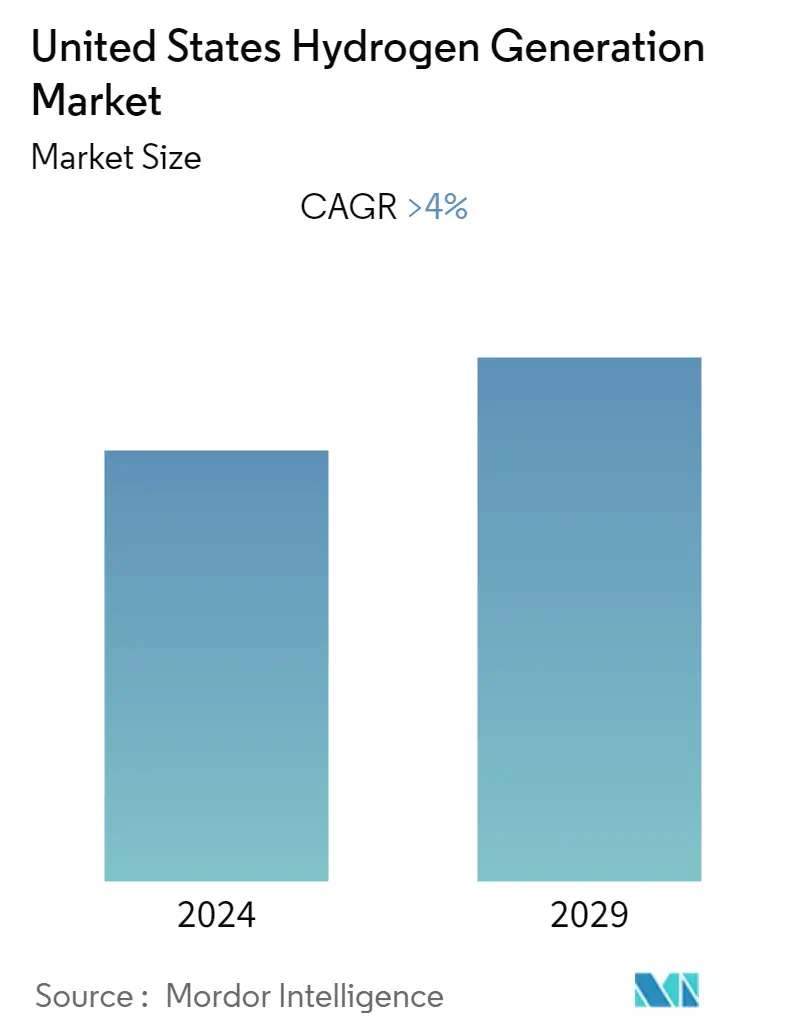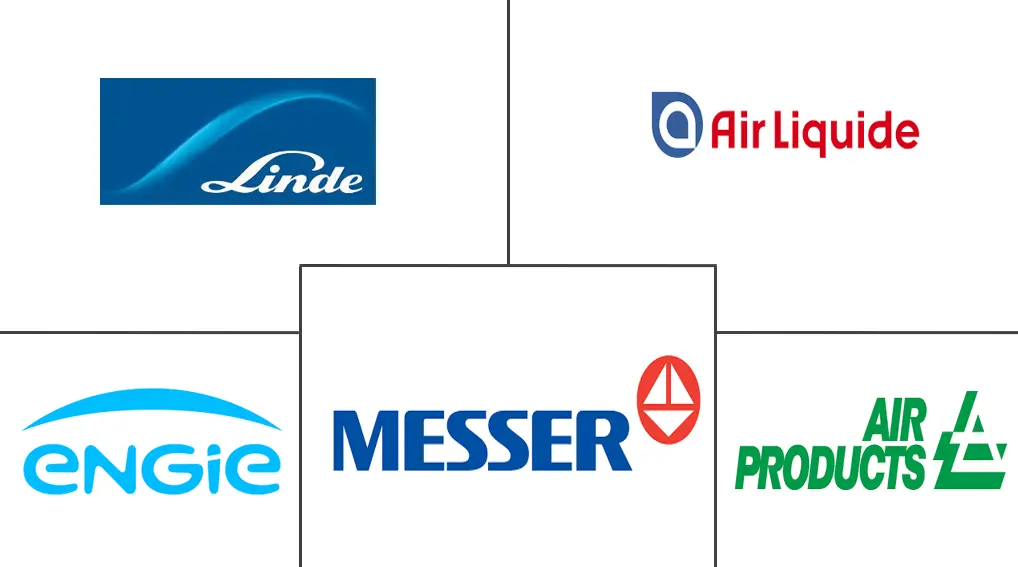Market Size of United States Hydrogen Generation Industry

| Study Period | 2019 - 2029 |
| Base Year For Estimation | 2023 |
| Forecast Data Period | 2024 - 2029 |
| Historical Data Period | 2019 - 2022 |
| CAGR | 4.00 % |
| Market Concentration | Medium |
Major Players
*Disclaimer: Major Players sorted in no particular order |
US Hydrogen Generation Market Analysis
The United States hydrogen generation market is expected to register a CAGR of over 4% during the forecast period.
The market was negatively impacted by COVID-19 in 2020. Presently the market has now reached pre-pandemic levels.
- Over the medium term, increasing investment in the development of hydrogen plants will likely drive the United States hydrogen generation market during the forecast period.
- On the other hand, high capital costs of hydrogen energy storage are expected to restrain the United States hydrogen generation market.
- Nevertheless, technological advancements in extracting hydrogen from renewable sources and increased applications of hydrogen as a fuel will likely create lucrative growth opportunities for the United States hydrogen generation market in the forecast period.
US Hydrogen Generation Industry Segmentation
Hydrogen generation is an industrial process for generating hydrogen gas from diverse domestic resources, including fossil fuels, biomass, and water electrolysis with electricity. There are several processes to produce hydrogens, such as natural gas reforming/gasification, electrolysis, renewable liquid reforming, and fermentation. The United States hydrogen generation market is segmented by source, technology, and application. By source, the market is segmented as Blue hydrogen, Green hydrogen, and Grey Hydrogen. By technology, the market is segmented as Steam Methane Reforming (SMR), Coal Gasification, and Others. By application, the market is segmented as Oil Refining, Chemical Processing, Iron & Steel Production, and Others. The report also covers the market size and forecasts for the United States hydrogen generation market across major countries. For each segment, the market sizing and forecasts have been done based on revenue (USD Billion).
| Source | |
| Blue hydrogen | |
| Green hydrogen | |
| Grey Hydrogen |
| Technology | |
| Steam Methane Reforming (SMR) | |
| Coal Gasification | |
| Others |
| Application | |
| Oil Refining | |
| Chemical Processing | |
| Iron & Steel Production | |
| Others |
United States Hydrogen Generation Market Size Summary
The United States hydrogen generation market is poised for growth, driven by increasing investments in hydrogen plant development and technological advancements in renewable hydrogen extraction. Despite the high capital costs associated with hydrogen energy storage, the market is expected to benefit from the growing applications of hydrogen as a fuel. The market has rebounded to pre-pandemic levels after the setbacks caused by COVID-19, and it is anticipated to continue expanding over the forecast period. Grey hydrogen remains the most prevalent form of production, although its carbon-intensive nature is prompting a shift towards greener alternatives. The North American region, with its significant hydrogen projects, is actively exploring non-carbon-intensive solutions to enhance the local value chain, presenting substantial opportunities for market growth.
The market landscape is moderately fragmented, with key players such as Linde plc, Air Liquide SA, Engie S.A., Messer Group GmbH, and Air Products and Chemicals Inc. leading the charge. Innovations like Wood plc's new steam methane reforming technology, which aims to significantly reduce CO2 emissions, and government initiatives like the Department of Energy's funding for regional clean hydrogen hubs, are set to drive demand for efficient hydrogen production infrastructures. The United States, producing a notable amount of hydrogen primarily through natural gas reforming and electrolysis, is witnessing increased advancements in cleaner technologies. These developments, coupled with strategic collaborations and investments in green hydrogen production, are expected to bolster the United States hydrogen generation market in the coming years.
United States Hydrogen Generation Market Size - Table of Contents
-
1. MARKET OVERVIEW
-
1.1 Introduction
-
1.2 Market Size and Demand Forecast in USD billion, till 2027
-
1.3 Recent Trends and Developments
-
1.4 Government Policies and Regulations
-
1.5 Market Dynamics
-
1.5.1 Drivers
-
1.5.2 Restraints
-
-
1.6 Supply Chain Analysis
-
1.7 PESTLE Analysis
-
-
2. MARKET SEGMENTATION
-
2.1 Source
-
2.1.1 Blue hydrogen
-
2.1.2 Green hydrogen
-
2.1.3 Grey Hydrogen
-
-
2.2 Technology
-
2.2.1 Steam Methane Reforming (SMR)
-
2.2.2 Coal Gasification
-
2.2.3 Others
-
-
2.3 Application
-
2.3.1 Oil Refining
-
2.3.2 Chemical Processing
-
2.3.3 Iron & Steel Production
-
2.3.4 Others
-
-
United States Hydrogen Generation Market Size FAQs
What is the current United States Hydrogen Generation Market size?
The United States Hydrogen Generation Market is projected to register a CAGR of greater than 4% during the forecast period (2024-2029)
Who are the key players in United States Hydrogen Generation Market?
Linde Plc, Air Liquide SA, Messer Group GmbH, Engie S.A. and Air Products and Chemicals Inc. are the major companies operating in the United States Hydrogen Generation Market.

